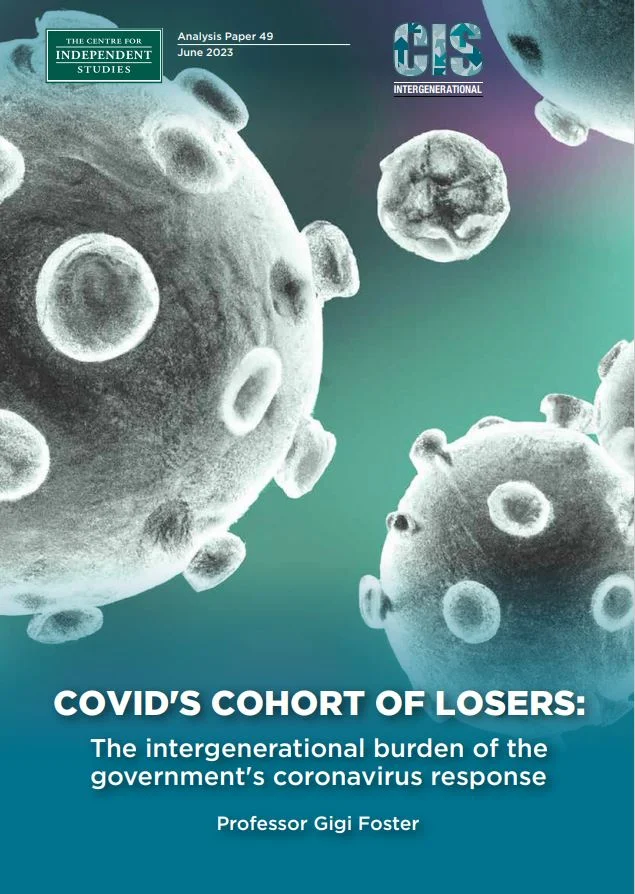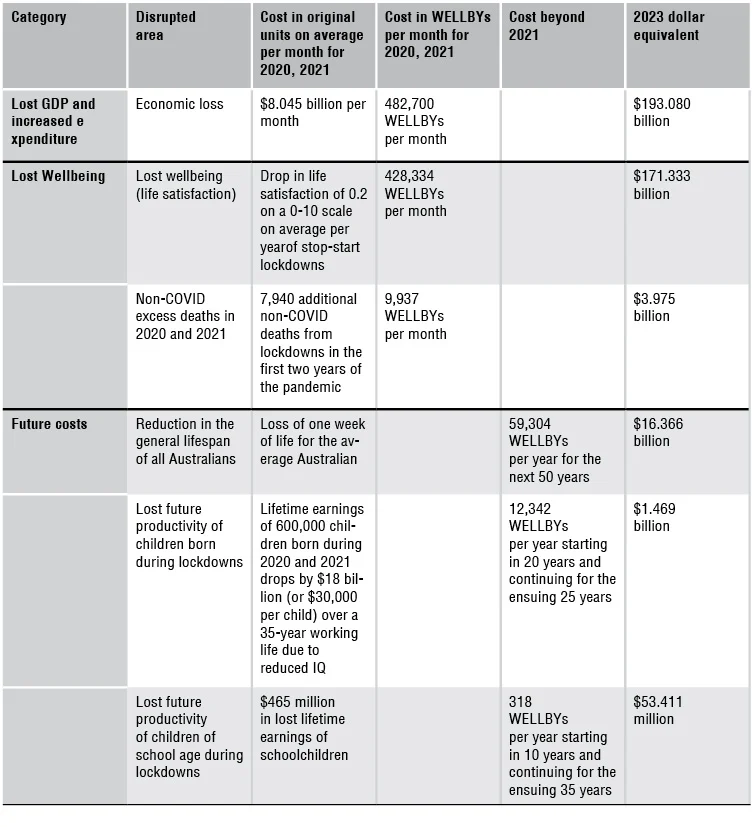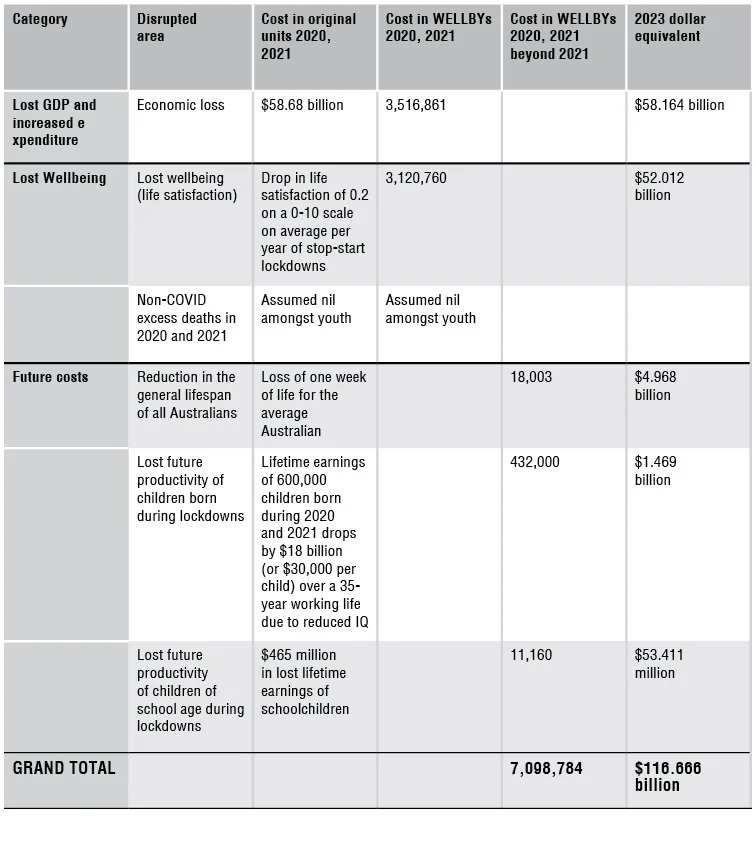

Executive Summary
Australia’s young people deserve to have their interests considered in Australian policymaking. In the Covid era, many policies were defended on the basis that they would help those vulnerable to Covid, mainly the elderly. In this report, I attempt to put a price tag on Covid-era policies, from the perspective of Australia’s youth.
The estimates in this report are based largely on my cost-benefit analysis of Australia’s Covid-era lockdowns, published in 2022 with Sanjeev Sabhlok. I also briefly consider the impact of other Covid-era policies, such as mass Covid vaccination, and the work of other analysts attempting to reckon with the total impact of Australia’s Covid lockdowns. The currency I use to estimate both the costs and the benefits of Australia’s Covid lockdowns is the recently invented WELLBY, or wellbeing year, which is also introduced, justified, and briefly explained in this report. The WELLBY is built from self-reported data on life satisfaction, and hence is particularly well-suited to capturing costs that affect people’s overall lives, rather than merely their health or their wallet.
I estimate in this report that the Covid policies Australia pursued have cost the nation’s youth at least 116 times the value of any benefit that they could have received from those policies. This figure draws on conservative estimates of known costs, and excludes estimates of likely direct damage from the Covid vaccine rollout, future negative fertility effects, or negative impacts on intangibles like social habits, trust, and motivation.
Covid-era lockdowns created huge damage to the lives of our young people. These costs are theoretically likely, and have already been shown in some studies, to afflict disproportionately those young people who were already disadvantaged at the start of the Covid era — meaning that our response to Covid has served to exacerbate existing social, economic, and health inequalities.
An enormous amount of additional government debt, relative to pre-Covid levels, will now ultimately be repaid by Australians aged 25 years or younger, a cohort that had the least to gain from the lockdowns imposed upon them.
Outside of the financial burden on this group which will imply lower future spending on everything that makes life longer and better, lockdowns brought a significant immediate reduction in wellbeing, as well as many other losses yet to be paid. My estimate of the direct losses to the wellbeing of Australia’s youth during lockdowns in dollar terms, extrapolated from the WELLBY currency, amounts to $52.012 billion. I conservatively estimate the total losses to young Australians of Australia’s Covid lockdowns to be $116.666 billion.
This represents a knockout punch to a generation of Australian youth, and one whose consequences they will carry until they die.
Introduction
The Australian government response to the Covid phenomenon included a range of policies that restricted personal liberties, closed businesses and schools while forcing lockdowns, with ensuing chronic economic and non-pandemic health impacts. All of these policies would have been seen as unacceptable prior to mid-March 2020 and had not previously been considered best-practice responses in pandemic planning.
These policies included school and playground closures, stay-at-home orders, enforced social-distancing and restrictions on international — and even interstate and intrastate — travel, the likes of which the Australian public had never endured. These policies, together with the targeting (from mid-2021) of whole-of-population Covid vaccination, were all justified by governments as necessary to save lives, despite the available evidence, even in March 2020, suggesting the virus was primarily a risk to the aged and already ill.
While the government reaction adversely impacted the wellbeing of Australians more generally, these policies had more severe impacts on younger cohorts. Not only were education and early careers disrupted but, in the longer term, all cohorts of young Australians will be forced to contend with the burden of historic debt levels and the social changes this will bring. To make it worse, this is a group for whom the risk of direct harm or mortality from Covid was negligible. The primary alleged beneficiaries of slowing the spread of Covid were those with only a few years left, on average, of healthy life, and the alleged benefit of lockdowns was therefore largely confined to this group.
The policies were extremely expensive. Their costs are not only in terms of the public funds directly committed to programs like JobKeeper and the massive expansion in social security, but also in terms of the significant reduction in wellbeing resulting from lockdowns and other restrictions on freedom. Recent Australian studies bear out the significant reductions in mental health and life satisfaction resulting from lockdowns and other Covid policies. An extra $617 billion of government debt, relative to pre-Covid levels, will now ultimately be repaid by younger Australians who had the least to gain — and much to lose — from the lockdowns imposed upon them. Health damage to youth[1] vaccinated multiple times with a medicine that in normal circumstances would be regarded as experimental against a virus that did not pose a serious threat to them also has emerged.
This paper distils the learnings from Australia’s first comprehensive, wellbeing-based cost-benefit analysis (CBA) of the government response to Covid (Foster & Sabhlok (2022) while also drawing on the results of other careful analyses of the impact of Covid policies on the young, including two other CBAs of Australian Covid policy, and frontier knowledge about vaccine side effects to date on the young. It focusses on how government policy during the Covid era impacted young Australians, and on the intergenerational equity implications of the distribution of the fiscal burden taken on due to Covid policy choices.
-
THE CONTEXT AND ANALYTICAL APPROACH
Context
In a democratic society, government policy is purportedly set on behalf of all citizens, and notionally chosen by representatives of the people to optimise their collective welfare. The mechanisms of policy accountability include direct democratic elections but also, within government, the scientific evaluation of the likely effects of policies — ideally conducted in advance of policy selection.
It has yet to be revealed what went on behind closed doors in March 2020, when Australia’s initial policy response to Covid was being devised and the trajectory of our subsequent policies was thereby being heavily influenced. To the public eye, however, Australian governments did not conduct a scientific evaluation of the likely effects of lockdowns and other Covid-era policies on the populations to whom those policies were being applied. Governments did not calmly consider a range of policy alternatives and select the one judged most likely to produce the highest net social welfare on aggregate. What instead appeared to transpire in mid-March 2020 is that extreme moves to stop trading, shutter schools, close borders, remove individual freedoms, and limit in-person human interactions outs
ide the home were taken by government officials without either examining the likely benefits of doing so, or explicitly estimating the costs of doing so. These policies were then defended to the public on the basis of asserted short-run connections between normal in-person human interaction, on the one hand, and suffering and deaths due to Covid, on the other.
What was ignored included the absence of scientific evidence that slowing transmission of the Covid virus would ultimately protect more people than allowing its transmission amongst the young and healthy, providing natural immunity in that group that exposure would create (i.e., pursuing the goal of herd immunity, whether perfect or imperfect). The absence of evidence that the chosen policies would in fact significantly lower transmission rates also was ignored, as were the many obvious short-run and long-run costs of interfering so dramatically with normal social and individual functioning within society.
Covid-era policymakers neglected the predictable damage to young people of policies like closing schools, stopping friends from seeing one another, and creating debt. The very lockdowns and school closures that were directly harming the young were marketed to them by manipulating their love for others, via a story of pro-social self-sacrifice that was necessary to save their grandmothers. The short-run and long-run costs of lockdowns, and the long-run costs of programs like JobKeeper that aimed to staunch the worst short-term wounds of lockdowns, were ignored.
Worse, those who spoke out against the government’s allegedly anti-Covid policies were denigrated, defamed or deregistered. One example amongst many is Ros Nealon-Cook, a child psychologist who spoke out in 2021 on behalf of children about the harms that they were experiencing from government-mandated school closures,[2] who was subsequently deregistered by the Australian Health Practitioner Regulation Agency (AHPRA).
Analytical approach
The standard means of conducting policy evaluation is cost-benefit analysis (CBA). In early 2020, best-practice stewardship of society would have been to estimate and weigh the costs of locking down economies against the projected benefits. This quantification of likely costs and benefits of a policy is the main job of economists within governments who evaluate government policy. The cost-benefit analysis method aims to take into account — whether formally quantifying or qualitatively acknowledging — all costs and benefits accruing or likely to accrue to all groups, including the young, from a given policy. Several different currencies may be used to capture a policy’s estimated costs and benefits, including monetary currencies like dollars, or human-welfare currencies like quality-adjusted life years (QALYs), disability-adjusted life years (DALYs), or other units of measure.
The questions that would have arisen as part of a CBA of Covid-era lockdowns in 2020 include the following:
- How much happiness and health will likely be lost because of social distancing and isolation
- How many lives will likely be lost, and how much suffering incurred, due to the crowding-out of healthcare for problems unrelated to Covid
- What are the likely long-term costs to children and university students because of school closures and reversion to online learning
- What economic losses are likely to be incurred by businesses forced to close or drastically curtail operations
- What effects should we expect lockdowns to have on economic inequality
- How much public investment will be foregone in future years because of the debt incurred by government policies to shore up household incomes during lockdowns
- What degree of inflationary effect will result from printing money without a corresponding increase in output
- What amount of benefit is realistically achievable by lockdowns
Each projected cost or benefit of lockdown policy would be calculated through comparing the likely outcome with lockdowns to the likely outcome in a counterfactual scenario in which the only difference is that no lockdowns occur — representing a state of the world in which Covid still emerged, but Australia’s leaders chose a policy other than lockdowns to fight it.
To illustrate how such questions could be approached, I prepared a draft CBA of lockdowns for the Victorian State Parliament in August 2020[3], in spite of believing that it was the responsibility of the Victorian government itself to provide rigorous justification for its lockdown policies. A greatly expanded and more detailed version of this initial analysis appears in my book with Sanjeev Sabhlok, published as “Do Lockdowns and Border Closures Serve the ‘Greater Good’? A cost-benefit analysis of Australia’s reaction to Covid-19” (2022).[4]
In order to properly aggregate and compare the costs and benefits of any public policy, including Covid countermeasures, it is necessary to convert all estimated costs and benefits to a common currency. By doing so, we can derive an ‘apples-to-apples’ comparison of costs and benefits needed to determine whether lockdowns were ‘worth it’. What currency is appropriate?
Introducing the WELLBY (Wellbeing Year)
Most authors of previous cost-benefit or cost-effectiveness analyses[5] of government policies use either actual currency, like dollars, or — especially for policies that are thought to affect human health in ways that cannot be captured directly in dollar terms — a health-oriented currency such as the Quality-Adjusted Life Year (QALY) or Disability-Adjusted Life Year (DALY). A quality-adjusted life year represents one healthy life year lived by a human (any human) with the value of 1, and a less-healthy year by a value that is lower than 1 by an amount that depends on the quality of the person’s health state. The DALY adjusts the value of one lived year specifically to account for any disabilities with which the individual is living. For space reasons I do not further examine the QALY and DALY currencies, but refer to Feng et al (2020)[6] any readers interested in an extended discussion of the history of and differences between QALYs and DALYs in the evaluation of health interventions.
Because Covid lockdowns were billed as a health intervention, with the sole goal of reducing Covid-related deaths and suffering, one might think of using either QALYs or DALYs to evaluate the impacts of Covid lockdowns. However, both QALYs and DALYs have drawbacks when it comes to measuring what is valuable about life overall. Most obviously, they count only dimensions of health and disability, without counting things like relationship quality, social status, the health and happiness of loved ones, the quality of experiences, a sense of meaning, or hope for the future. These phenomena do generally impact people’s subjective quality of life, which is itself a far broader concept of what is worthwhile to aim for in policy. Subjective quality of life is a yardstick that can be applied to interventions not only in the realm of health – as health is an important driver of overall quality of life – but in any area where the government intervenes. The list of potential harms of lockdowns given above demonstrates that lockdowns affected far more areas of life than health alone, and this damage would not be captured in an analysis limited to QALY- or DALY-denominated impacts of lockdowns.
For these reasons, to evaluate Australian Covid lockdowns, I chose as the primary currency the newly-developed wellbeing life year (WELLBY) currency (Frijters et al 2020)[7]. The WELLBY directly quantifies the holistic satisfaction received from a life in a given year as reported by the person living that life, thereby taking seriously people’s own evaluations of their lives overall, rather than appealing to a third-party metric that maps each aspect of someone’s life into some pre-determined value, as done by the QALY and DALY currencies. In this the measure is radically democratic, while also capturing a potentially unlimited number of drivers of human thriving and accommodating diverse perspectives (i.e., all perspectives of those actually doing the living) on what is felt to be most important about life.
WHAT IS A WELLBY AND HOW IT WORKS
One WELLBY (wellbeing year) is defined as a one-unit increment of life satisfaction on the 0-to-10 scale typically used to answer the survey question, “Overall, how satisfied are you with your life nowadays?”, enjoyed by one person for one year. Such a question appears on many social science surveys worldwide, including the well-known Household, Income and Labour Dynamics in Australia (HILDA) annual survey-based data set. Survey responses to this life satisfaction question indicate that the answer to this question for a healthy person living in Australia is around an 8, and the answer by someone indifferent between life and death is about a 2[8], meaning that roughly 6 WELLBYs is equivalent to one healthy life year lived (which can be equivalently represented by one QALY). The number of WELLBYs enjoyed by a given person increases when that person’s life satisfaction rises for any reason they perceive – whether due to better health, better relationship quality, a better job, or anything else – and falls when, for whatever reason, the person’s life satisfaction deteriorates. Qualitative changes in life satisfaction achieved through adjustments to non-health-related dimensions of life result in changes in WELLBYs enjoyed that are not captured in QALYs, while changes in health status or in the number of life-years lived are captured effectively by both currencies. Changes in life years are captured by the two currencies at a standard exchange rate, because one healthy life year lived is represented in QALY terms with a value of one, and in WELLBY terms with a value of 6. Hence, the loss of one healthy life-year due to someone’s death a year earlier than expected (say, due to a policy that creates obstacles to receiving regular health care) is captured by the loss of 1 QALY or, equivalently, the loss of 6 WELLBYs.
In this manner, WELLBYs can be translated to QALYs when tabulating gains or losses in human lives. We also know how much Australian society is willing to pay to achieve one QALY from health services, because the Therapeutic Goods Administration pays drug companies for their products based on the QALYs those products are expected to save. The maximum price paid by the Australian government for one QALY’s worth of health improvement in normal (i.e., non-Covid) times is between $50K and $100K. This willingness to pay for a QALY gives us a translation of dollars to QALYs – i.e., how many dollars would we normally pay to save one QALY? – and hence from dollars to WELLBYs as well. These numbers compare favourably with the UK Treasury’s rule of thumb that 10-12,000 pounds of government expenditure are needed in order to produce one WELLBY.[9]
In sum, the reasons I chose the WELLBY to evaluate Covid lockdown policy, rather than a currency like dollars or QALYs, are as follows:
-
-
-
-
-
-
- Unlike dollars, WELLBYs count human wellbeing costs and benefits. Thus, the WELLBY directly targets the maximand of economics and (ideally) policy — human thriving, rather than dollars.
- Unlike QALYs or DALYs, the WELLBY captures mental wellbeing that is driven by input beyond merely health — including the quality of relationships, social status, or anything that enriches individuals’ lives in their own estimation.
- As it is built from self-reported data, the WELLBY counts what people report about the quality of their lives, rather than assuming that supposedly objective measures, like income or disability status, determine the amount of welfare they are enjoying according to fixed formulas used by the analyst.
-
-
-
-
-
-
COST CATEGORIES AND ESTIMATES
My 2022 analysis of Covid lockdowns covered only effects occurring or estimable based on events that took place in 2020 and 2021. In some cases, new data have since emerged that enable a refinement of the estimates. In addition, my analysis was of lockdowns and associated orders
to cease work, study, and travel, and government policies intended to stem the damage of such policies, such as large fiscal outlays (e.g., JobKeeper). I did not evaluate policies about masking or Covid vaccinations, which have also affected the young during this period. In this section, I focus only on the costs of lockdowns and associated policies.
To preface the quantitative estimates in this section, it is appropriate to take a moment to re-live the effects of Covid policies in these years on an inhabitant of Australia. With schools closed, stay-at-home orders in effect, and workplaces shuttered, people lost their normal lives and their ability to choose social interaction if they wanted or needed it, which will have cost them happiness, as humans are social creatures. They also lost their sense of purpose from professional activities, being forced to stay at home and collect a government cheque for doing nothing. Robbing people of normal social relations and professional purpose was already a huge mental blow. On top of that, those who fell sick or became injured were often unable to access normal healthcare, and people living in dysfunctional families or poor living conditions were more exposed than usual to the stresses of those conditions. People even faced government-sanctioned caps on how much exercise they could engage in per day and how much time they could be outside in the sun, which ironically is nature’s optimal source of Vitamin D, known for decades to be protective against viral infections (https://www.ncbi.nlm.nih.gov/pmc/articles/PMC3308600/).
These direct negative effects of lockdowns are only one part of the story, however. Deficit spending financed those government cheques, and as a result the Commonwealth debt grew. In my CBA, I conservatively estimate that only half of the excess debt of AU$356 billion incurred in 2020 and 2021 was due to the attempts to staunch the damage of lockdowns and otherwise conduct the government’s anti-covid policy agenda.
This debt matters because the need to re-pay it in future years will imply lower spending by the government on all other line items. Government spending on public services, programs and institutions, like health care, education, and infrastructure, increases the length and quality of lives. In particular, as indicated above, the UK Treasury estimates that, on average, government spending of 10,000-12,000 pounds produces one WELLBY. I assume a similar rate of return to Australian government spending (specifically, that $100,000 of government spending could produce 6 WELLBYs) in order to translate the debt accumulated in 2020 and 2021 into a number of WELLBYs lost due to the crowd-out of useful government spending in future years via the need to repay Covid-era debt associated with lockdowns.
Other costs of lockdowns include crowded out healthcare that will cost lives and quality of life in future years, lower-quality education for children due to school closures, and reductions in the future capacity of babies born during lockdowns due to dysfunctional caring environments . The latter two of these costs will be borne by our youth.
Table 1, built from the summary table of costs presented in my CBA, lists the main estimates of the costs of Australian Covid lockdowns across six different core dimensions of life that matter to humans. The damage done in each disrupted area is assessed in its original units, then converted to the common currency of the WELLBY, and finally converted into a 2023 Australian dollar equivalent assuming a conservative discount rate of 5 per cent for all costs incurred beyond 2021.[10] These conversions are made according to the rules of thumb outlined in the WELLBY text box, and also assuming conservatively that government spending, not private spending, produces WELLBYs.[11]
TABLE 1. ESTIMATED COSTS TO AUSTRALIAN POPULATION OF 2020-21 LOCKDOWNS
Immediate Costs
The first three rows show estimated costs incurred during the 2020-2021 lockdown period in Australia. The first row captures the loss associated with substituting present spending for future spending — a cost that young people will bear directly in their lives, as the debt taken on in 2020-2021 will need to be paid back later, crowding out future government spending. Government spending on standard line items that promote human thriving, like infrastructure, health, and education, will now be lower in future than it would have been had lockdowns and associated damage-staunching policies, like JobKeeper, not been chosen by Australian leaders.
The second row captures the cost of losses in life satisfaction during the 2020-2021 lockdown period. Data that has emerged since the end of 2021 does not change the estimates of wellbeing losses or losses incurred due to lockdown-related spending, since these losses were incurred in the immediate term, while lockdowns were active.
Together, these first two rows account for more than 90 per cent of the total costs of lockdowns estimated in my CBA. They amount together to 21,864,816 WELLBYs (equivalent to $364.413bn). This is the same number of WELLBYs that the Australian government would normally be willing to pay $364bn to save.
The third row shows estimates of the human losses due to the laser focus on Covid as a health threat in 2020-2021. Other illnesses and injuries were relegated to a lower tier of importance, meaning that those unlucky enough to suffer from them were likely to be given a lower standard of care than in normal times. This cost lives in 2020 and 2021, as shown in the number of non-Covid-related deaths that I estimate resulted because lockdown policies caused health care for other conditions to be crowded out.[12]
Future Costs
The final three rows of Table 1 display estimates of costs (apart from debt repayment) that will emerge over time, starting after the lockdowns ended. These costs are discounted by an annual rate of 5 per cent so that they can be summed together with the other lockdown costs expressed in 2021 well-being currency.
First, I estimate that the Australian government’s Covid lockdowns and associated policies in 2020 and 2021 will cause a one-week reduction in average lifespan of all Australians alive during the Covid era. This is a conservative estimate based on long-term health effects of the 2020-2021 lockdowns such as increased obesity, alcohol and substance use, other less healthy habits, and healthcare crowd-out.
In the final two rows of Table 1, I estimate the losses in future productivity that will be suffered by those who started life or were children during the Covid era. These estimates are based on best guesses about the impact of reduced human capital due to school closures, the development of bad habits, being cared for and taught by masked and often anxious adults, the loss of normal social interaction, and heightened exposure to the risks of being indoors at home (e.g., heightened risks of family and sexual violence, breathing lower-quality air, and reduced levels of exercise). The WELLBYs that would otherwise have been created through proper care and schooling during this period would have by assumption been delivered by the government expenditure financed by 40 per cent of the foregone earnings of these children once they reach adulthood, with private expenditure (i.e., 60 per cent of these foregone earnings) assumed to be spent in status races and thereby not to contribute to additional human thriving. For further discussion of this issue, see the Frijters and Krekel (2020) handbook chapter.
The net present value calculations underpinning the estimates in Table 1 are available in the public domain on Sanjeev Sabhlok’s website .[13]
Particular Impacts on the Young
Table 2 takes each item in Table 1 and distils out the costs in WELLBYs that are specific to the young, defined as that fraction of the population under age 25. By totalling each of these line items, we can derive an approximate total cost to the young from the 2020-21 Covid lockdowns.
TABLE 2. ESTIMATED COSTS TO THE AUSTRALIAN YOUNG OF THE 2020-21 COVID LOCKDOWNS
Which of the costs in the first three rows of Table 1 will be paid by the young? Most obviously, today’s youth will be tomorrow’s adults living a worse life because their country will be poorer, due to the Covid-era loss in GDP and accumulated debt that must be repaid. In Table 1 these costs were not discounted, as the repayment schedule and hence the trajectory of future expenditure crowd-out is unknown, and I adhere to that convention in Table 2. To estimate the fraction of such costs that the young will bear, I simply take the fraction of the Australian resident population aged 25 and younger,[14] and multiply this fraction by the total estimated cost. This is a highly conservative estimate because younger Australians will live more of the human life-years lived in the future than will older Australians, suffering in more years of their lives than older people from the reduction in future quality of life represented by these costs.
Young people were also amongst those who suffered losses in life satisfaction during the Covid lockdowns. In fact, according to an analysis of the April 2020 ANU Poll data by Nicholas Biddle and colleagues,[15] people in the 18-24 and 25-34 age groups were statistically significantly less satisfied with their lives that month, relative to their pre-lockdown reported life satisfaction in January 2020, compared to those in older age groups — indicating that lockdowns disproportionately damaged the life satisfaction of Australia’s youth. Nonetheless, to be conservative, I apportion the direct life-satisfaction costs of lockdowns to youth by simply multiplying the total estimated loss by the fraction of the population under 25 years of age.
Most excess deaths in 2020 and 2021 occurred amongst the elderly, but a modest number of those who died due to the privileging of Covid in the healthcare sector during 2020 and 2021 will have been young. However, for the purposes of this conservative analysis of the costs of Covid policies borne by youth, I assume no such deaths due to lockdown-era healthcare crowd-out in 2020 and 2021 occurred amongst those below 25 years of age.
Hence, of the costs enumerated in Table 1, both the largest and second-largest ones will be or were (according to ANU Poll evidence) borne disproportionately by youth. Mental health losses suffered in 2020 and 2021 by young people should also be expected to predict years more of higher risks to mental health, since when mental health problems occur once, they often recur.[16]
Further, all future costs enumerated in Table 1 will be borne disproportionately, if not entirely, by youth.
Under highly conservative assumptions, the lower-bound estimated costs of Covid-era lockdowns and associated policies in 2020 and 2021 apportioned to the young, as displayed in Table 2, amount to 7.098 million WELLBYs. This is an amount of damage that in normal times, assuming a willingness to pay $100,000 to ‘buy’ one QALY via government expenditure, Australia would pay approximately $116.7bn to avoid.
-
EFFECTS ON DEVELOPMENT AND FUTURE PRODUCTIVITY OF THE YOUNG
In this section, I provide more details on the mechanisms through which lockdowns generated the costs to the human development and future work productivity of the young.
Reduction in Training
Lockdowns interfered with the training of apprentices and young workers in Australia. For example, there was a “steep rise” in contract suspensions in Victoria in March, April, May and again in August in Victoria during lengthy lockdowns.[17] This occurred not only through less learning by doing, but also because there were fewer interactions that customarily occur in the workplace, informally around the coffee station, the water cooler, in the elevator or in the lunchroom. These interactions are valuable to young workers in forming productive links and gaining insights from more experienced workers. They cannot be replicated through online activities.
This loss of training for young workers extended sporadically for two years and is likely to have lifelong adverse impacts on their productivity and earning capacity.
Fewer Opportunities for Leadership Development
Lockdowns will have had an adverse effect on the development of leadership skills of young people, partly due to less workplace training, as noted above, and partly because of the extended absence from active participation in sports, arts, music and community activities, all of which are essential inputs for leadership skills development and, more generally, for the development of normal social skills.
Lifetime Reduction in Productivity of Children Born During Lockdowns
Lockdowns derailed the normal functioning of families and communities that nurture children in normal times, which inevitably leads to an adverse long-term impact on children. One of the most pernicious mechanisms of this damage is impeded brain development, because this results in lower overall mental and emotional capacity, including lower IQ, that the affected child will carry throughout his or her life. The brain is far more malleable during infancy and toddlerhood than at any other point in life, meaning that opportunities for brain growth lost during the earliest years of life cannot easily be made up for later in life.
In a longitudinal study of children in Rhode Island that has been running for 12 years (Deoni et al. 2021), the average IQ of those born after the beginning of the pandemic dropped 22 points compared with the average for pre-pandemic cohorts.[18] [19] Declines in IQ were attributed by Deoni et al. to negative effects of lockdowns on the mother while pregnant, as well as to changes in the relationship of the infant with adults and children after birth, with effects highest among males and in families with lower socioeconomic status. As just one example of one such mechanism, masking may have caused direct damage to children’s cognitive development, judging from a 2009 experiment by researchers at the University of Massachusetts finding that children become disoriented when confronted by non-responsive faces.[20] [21]
While not yet published in a peer-reviewed journal, the initial findings in the Deoni et al. study from Rhode Island carry worrisome implications for the approximately 600,000 children born in Australia in 2020-21. Even if the average IQ of 600,000 Australian children dropped permanently by only a few points, the impact on future productivity and wages is likely to be material, as discussed in the next subsection.
Impact of IQ on Future Earnings
The impact of IQ on future earnings is challenging to identify because of the coincident impact of social, cultural and economic factors. In particular, children with higher IQs also tend to have other advantages.
High school grade point average (GPA) has been argued to be a reasonable reflection of innate intelligence, and less impacted than other measures, like SAT scores, by contaminating social and economic factors.[22] The figure below, reproduced from my CBA (Figure 13.1) and originally appearing in the Washington Post,[23] shows a fairly robust relationship between intelligence as measured by high school GPA, and adult annual earnings.

Figure 1: Relationship between High School GPA and Earnings in Adulthood
To recover an estimate of the loss to total lifetime earnings for a child whose IQ dropped by one standard deviation due to lockdowns — which would then be expected to produce approximately a one-standard-deviation drop in high school GPA, in a country like Australia where most children born do attend high school — would require multiplying the expected dollar figure loss in one year by the number of years of that child’s expected working life. A one-standard-deviation change in GPA has been found to be approximately 0.75 points,[24] which translates to approximately US$5000 based on the mapping shown in Figure 1. Conservatively ignoring the USD-AUD exchange rate conversion and multiplying this annual decrement by 35 to represent the average number of years of working life, we recover an undiscounted loss of AU$175,000 of lifetime earnings per child so affected.
If all of the roughly 600,000 Australian children born in 2020 and 2021 were to have suffered a one-standard-deviation loss in IQ, the predicted undiscounted loss to their future lifetime earnings would be estimated to be AU$105 trillion. At the previously discussed exchange rate of $100,000 of government expenditure (financed by 40 per cent of these lost earnings that would otherwise have been collected as tax revenue) per QALY, this would equate to more than 400 million QALYs, or 2.5 billion WELLBYs, of lost human welfare for youth due to lockdowns — all yet to be paid.
To the extent that IQ losses caused by lockdowns and associated policies end up being on average more or less than one standard deviation, this number will be higher or lower. In addition, as noted in the Deoni et al 2021 study, one might expect that losses to children born in richer families will be lower than losses to children born in poorer families, both because the rich have more resources with which to compensate for losses and because they found it easier than did the poor to cope with the stresses that lockdowns created.
We can hope that average losses turn out to be significantly less than a full standard deviation found in Deoni et al 2021, once more research on this important topic is conducted. Being conservative, I assumed in my CBA and in Tables 1 and 2 an amount of lost foregone earnings due to lower mental capacity worth only approximately 17 per cent of what would be implied by a full one-standard-deviation reduction on average for the cohort of people born in 2020 and 2021 – i.e., a loss of $30,000 per child in lifetime earnings, rather than $175,000 per child.
Lifetime Reduction in Productivity from Disrupted Schooling
Like the children born during lockdowns, children who were of school age during lockdowns suffered in ways particular to their cohort, despite being at virtually zero risk of serious Covid symptoms or even of spreading it disproportionately to their teachers. An analysis by the Public Health Agency of Sweden, which kept schools open for all children under 16, in June 2020 showed no statistical difference in paediatric Covid cases between Sweden and Finland, and no increased risk to teachers compared to other professions.[25]
In 2020, I attempted an early analysis of the likely effects on children of Covid-era school closures, based on lockdowns observed to that point.[26] In my study, I conservatively estimated that online learning was 90 per cent as effective as in-person learning in school classrooms, and focussed only on costs in the currency of foregone earnings losses, ignoring many other potential categories of longer-run impact on children (e.g., in their personal and civic lives, and in the realm of physical health). I extended the findings of that study in my CBA to incorporate the full duration of Australian lockdowns, significantly increasing the estimated lifetime-earnings losses to approximately $465 million, or 27,900 WELLBYs, for the entire cohort of people attending school during the lockdowns.[27]
University students too felt the effects of online learning being used as a substitute for in-person learning. It remains unknown how much damage was done by this policy to university students’ future earnings potential. Future analyses of university grades delivered in 2020 and 2021, moreover, are unlikely to assist much due to the usual pressure towards making grades conform to a standard distribution year-over-year, coupled with special Covid-era changes to rules and assessments implemented by universities to try to ease the disruption of such policies. This means that at least some of whatever loss in training during university has occurred will be hidden in normal measures of success like university grades. To be conservative, I omit from my estimates any lifetime earnings losses for the university-student cohort — or any other cohort of students (e.g., at TAFE or in executive postgraduate programs) imposed by Covid lockdowns.
-
ALTERNATIVE APPROACHES BY OTHER AUTHORS
Other authors have also carried out cost-benefit analyses of Covid lockdowns in Australia, each with varying approaches, and drawing from my work to incorporate some costs that are difficult to quantify.
Martin Lally published a cost-benefit analysis of Covid lockdowns in Australia in 2022.[28] Using QALYs[29] as his currency, he estimated that the number of additional deaths from a targeted mitigation strategy, relative to the broad-based lockdowns, would have been 11,500 to 40,000. Accounting for the well-known and documented fact that the vast majority of Covid mortalities were seen in individuals in more advanced aged groups and with comorbidities, this implies a cost per QALY saved by lockdowns of more than 11 times the generally accepted Australian benchmark for health interventions of $100,000.
Lally’s approach, however, makes no attempt to explicitly isolate the effects of Australia’s Covid lockdowns on young people.
Morgan Begg and Daniel Wild at the Institute for Public Affairs also produced a cost-benefit analysis for Australia in 2022.[30] They estimated net direct economic costs between March 2020 and June 2022 of $260 billion. They also evaluated the costs of lost schooling but did not attempt to convert these into a currency. Rather, they concluded:
All students suffered significant educational setbacks. This detriment was most pronounced in Victoria, where students missed more than five terms of in-person schooling, which resulted in Year 9 students falling behind by the equivalent of 12 weeks and 17 weeks of reading and numeracy skills, respectively.
Research conducted by Centre for Independent Studies education program director Glenn Fahey in October 2021 estimated that from 6 to 14 per cent of students were likely to have progressed more slowly during home-based remote learning (https://www.cis.org.au/publication/beating-lockdown-blues-students-pass-the-covid-test/).
Brownstone Institute[31] has been a major media channel for gathering, analysing, and disseminating information on the effects of Covid countermeasures around the world from a range of experts in the fields of medicine, economics, philosophy, law, psychology, and other disciplines. There has been no specific geographic focus of this mountain of material, although the Brownstone readership is disproportionately American. Nevertheless, much expertise has been offered by Brownstone authors on the effects of Covid policies on children, particularly in regard to the immediate harms wrought by masking and school closures.
A search of the articles on the Brownstone site using the keyword ‘children’ yields 42 pages of articles. Direct links to articles from the first 10 pages, from October 2021 to March 2023, are included in a supplemental reference list below. Some of these articles relate to the effects on children of Covid vaccinations, which are not part of any of the aforementioned cost-benefit analyses, but are touched on briefly below.
-
ADDITIONAL COSTS TO YOUTH YET TO BE ESTIMATED
What costs to the young of Australian Covid policies have not yet been estimated?
The main cost that has not yet been estimated is that of the mass Covid vaccination roll-out. Up through the 2022 financial year, the Commonwealth Department of Health had committed a total of $7.2 billion to the Covid-19 vaccine rollout.[32] This financial cost is included already in the measure of excess fiscal outlays (i.e., line 1 of Tables 1 and 2), but there is also growing evidence that the Covid vaccines are also associated with an abnormally large number of adverse effects, including both disablement, temporary and permanent, and death.
One recent analysis based on a study of the US Vaccine Adverse Event Reporting System (VAERS) and UK Yellow Card reporting systems concluded that through to 23 March 2023, there had been an estimated 120,000 deaths in the US directly attributable to the vaccines and 16,000 in the UK through to 29 September 2022. The report added that the number of deaths was a small fraction of the total number of adverse events, which in the US amounted to a little under 950,000.[33] While a full analysis by age has not been produced, evidence suggests that Covid vaccine side effects are more evenly spread across age groups than the health damage of Covid itself, so a significant number of these adverse effects will have affected people below age 25. Population-adjusted figures for Australia based on the study above, using the average of the estimated Covid vaccine death rate in the US and the UK, would suggest that through to the end of September 2022, in the order of 7,679 Australians have died from the Covid vaccine, while using the US rate of non-fatal adverse events (AE), 73,532 Australians have suffered such an AE.
Data on excess deaths from the Australian Bureau of Statistics also has drawn attention to the possibility of a significant number of Covid vaccine deaths in Australia.[34] The data for 2022 showed a 15.3 per cent increase in deaths over the historical average, with the age-standardised death rate in every month of 2022 higher than in the preceding three years. This 15 per cent increase represents about 25,235 extra deaths than expected based on trends, of which if the above estimates of Covid vaccine deaths are roughly correct, approximately 30 per cent could be reasonably apportioned to have been caused by the Covid vaccines. The ABS authors note that the number of deaths reported as Covid deaths had increased as the pandemic went on. However, deaths from other causes such as cancer, dementia, and diabetes have also been increasing above their historical averages.
To fully account for the costs of these excess deaths and injuries to Australia’s youth would require both a full reporting of deaths and injuries by age, plus a determination of how serious the various non-fatal adverse events have been, in terms of impacting life satisfaction. These data are as yet unavailable in Australia and so I do not attempt to quantify such losses, but evidence from other countries suggests that the potential is there for significant costs to youth, in the form of both death and disablement, to have resulted from the Covid vaccine rollout. The 70 per cent of ABS-reported excess deaths that could reasonably be attributed to delayed effects of other Covid-era policies are arguably already included, at least to some degree, in the estimates shown in Tables 1 and 2 regarding overall longevity reductions for all Australians alive during the Covid era.
Another cost of Australia’s Covid policies that has not been estimated in existing work and would disproportionately impact youth is the potential cost to fertility. While some impact on this may come directly from vaccinations,[35] an additional impact on fertility may come from social forces impacted by Covid-era policies that impede partnership formation and later mating, such as less-frequent social mixing of youth and more studying and working from home. Birth rates reported by the ABS in 2020 and 2021 (the latest available) are within the bounds of broad trends, leading to no immediate estimable impact of lockdowns on fertility. It is too early to estimate Australian fertility effects beyond 2021 and so I do not attempt to quantify them here, but emerging evidence from other Western nations that more promptly report their births than does Australia indicates that birth rates have fallen by approximately 10 per cent starting nine months after the Covid vaccine rollouts to fertile (i.e., young) segments of the population.[36] Should this estimate hold up and continue into future years, the costs to future generations of our Covid-era policies may be large-scale, quite apart from any accounting of whether those babies who do reach full term and are born to vaccinated mothers can expect to enjoy lives of normal length and health.
Other less tangible costs that have not been directly enumerated in the above estimates include those associated with the ongoing costs of bad habits yet to be shaken; loss of trust in each other and in institutions, and lack of motivation and drive. Some Australian youth may also move overseas for a better life, ultimately because of the way in which the country responded to Covid, depriving Australia of its human capital.
-
BENEFITS OF AUSTRALIA’S LOCKDOWNS
In my cost-benefit analysis of Australia’s lockdown policies, I made generous assumptions on the side of the government, giving lockdowns every opportunity to have had large estimated benefits.
These potential benefits include, most obviously, averted Covid deaths and suffering, but extend to improved productivity from working at home, long-term productivity improvements, and environmental benefits. The actual benefits of lockdowns that were not anticipated beforehand also include lower traffic accident mortality and lower mortality from accidental homicides, both of which are gains enjoyed by people on average far younger than the average Covid victim.
Non-Covid-Related Benefits
I estimate no net long-run economic benefits of Covid lockdowns, for the simple reason that there has so far been no clear sign yet of improvement in Australian labour productivity as a result of them. If anything, despite impressive harvests and the laying of new telecommunications infrastructure during the Covid era,[37] labour has shifted into less-productive sectors, though overall labour productivity measures look approximately on trend. I also estimate zero net effect on the environment, with potential benefits and costs in this realm of which both are likely of third-order importance at best.
Deaths during lockdowns were lower than usual, which is likely to have been at least partly due to lower use of motorised transport and less frequenting of clubs and pubs — some of which leads to accidental death. Based on data from the ABS, the Australian Road Deaths Database, and Macrotrends,[38] [39] [40] I estimate a saving of 96 lives in 2020 and 41 lives in 2021 due to lockdowns that would otherwise have resulted from traffic accidents or homicides. These benefits are likely to have been among people younger than average, as such people are more likely to drive most recklessly, frequent pubs and clubs, and commit violent acts. Converting this benefit into a quantity of human wellbeing, assuming that the average homicide or road-accident victim has 50 healthy years left to live that would otherwise have been enjoyed, yields a total of 6550 QALYs, or 39,300 WELLBYs (worth $655 million in normal times), saved by lockdowns. To be generous to lockdowns’ potential benefit to young people in this report, I take this entire benefit as accruing to those under 25.
Covid-Related Benefits
How many Covid deaths and other suffering (e.g., ‘long Covid’) may have occurred amongst youth, in an Australia without lockdowns, in 2020 and 2021?
In my CBA, I compare Australia’s Covid deaths in 2020-2021 to the deaths experienced in other Western nations that did not impose strict restrictions — specifically, Sweden (as one counterfactual), and a set of nations with low restrictions (as a second counterfactual), namely Belarus, Sweden, Finland, Estonia, Taiwan and Norway. Of these two counterfactuals, the latter yields the higher estimate of Covid deaths prevented in 2020 and 2021 by lockdowns, and so to be generous to lockdowns, I use that number — specifically, 12,304.
However, not all of these potentially avoidable Covid deaths were in fact avoided in Australia. In 2020 and 2021 Australia witnessed 2,353 Covid deaths according to Worldometer.[41] Therefore, at most 9,951 COVID deaths (i.e., 12,304 minus 2353) might have been postponed by Australian lockdowns.[42] As more than 10,000 Covid deaths since the start of 2022 are reported by Worldometer for Australia, it is likely that a large fraction, if not all, of the roughly 10,000 people whose lives were potentially ‘saved’ from a Covid death by lockdowns in 2020 and 2021 passed away soon afterwards anyway.
How many of these potential avoided Covid deaths would have been of people under 25 years of age? The Australian Bureau of Statistics reports that as of October 2022, only 68 Covid deaths had occurred among people younger than 40, across the country. Being highly generous to lockdowns, I assume that 50 of these deaths would have occurred in 2020 or 2021 and in people under 25. I further assume that none of the young whose Covid deaths were avoided in 2020 or 2021 has yet, or will in the near future, succumb to Covid anyway.
In my CBA, based on a review of the most recent evidence about the incidence and severity of ‘long Covid’, I estimate a quantity of losses due to long Covid that is equivalent to 2 per cent of Covid deaths.
Total Covid-related human losses to people under 25 years of age that may have potentially been avoided by Covid lockdowns can thus be estimated by calculating the estimate of avoided lost lives due to Covid in 2020 and 2021, multiplying this by the years of life saved per average young Covid death, and multiplying again by 1.2 to accommodate avoided losses due to long Covid. Assuming that an average young Covid victim would have 60 years of healthy life left to live, this yields (60*(50))*1.2 = 3600 QALYs, or 21,600 WELLBYs, of human wellbeing saved due to the lockdowns for young people to enjoy.
As costs of Covid vaccination were briefly touched on above, it is fair to ask whether Covid vaccines may have delivered benefits to the young that should also be counted. People under the age of 25 very rarely die of Covid, as is clear from the ABS data cited above. Further, the Covid vaccines provide only limited-time benefits and in the longer run appear to be associated with higher rather than lower rates of infection and death, including potentially from Covid itself.[43] I have found no evidence in favour of counting any health benefit to the young resulting from Covid vaccination.
Conclusion
Then Prime Minister Scott Morrison claimed while campaigning before the May 2022 election that his ‘regime’ of Covid policies had saves 40,000 lives.[44] My analysis shows this figure to be a significant over-estimate, even being generous to lockdowns’ potential to deliver benefits. Moreover, even if this inflated estimate were true, Australia would have only been willing to pay about $20 billion to avoid this quantity of human loss, as revealed in the country’s decisions about health expenditures in normal times. In fact, our country has paid easily 20 times that amount, and finds itself coming out of the Covid era with excess deaths rising and many costs incurred during this period yet to be felt, particularly by our young people.
I estimate in this report that the Covid policies Australia pursued may have delivered at most a quantity of human benefit to Australia’s youth worth 60,900 WELLBYs. Yet even using conservative estimates of known costs, and excluding estimates of likely direct damage from the Covid vaccine rollout, future negative fertility effects, or negative impacts on intangibles like social habits, trust, and motivation, lockdowns created damage to the lives of our young people in the amount of 7,098,000 WELLBYs –more than 116 times the upper-bound value of the estimated benefits of Australia’s Covid policies. These costs are theoretically likely, and have already been shown in some studies, to afflict disproportionately those young people who were already disadvantaged at the start of the covid era — meaning that our Covid response has served to exacerbate existing social, economic, and health inequalities.
Australia’s Covid-era policies have, in sum, delivered a knockout punch to a generation of Australian youth, and one whose consequences they will carry until they die.
ENDNOTES
[1] E.g., Natalie Hamilton: https://www.perthnow.com.au/news/mum-breaks-down-over-daughters-death-after-moderna-vaccination-during-senate-inquiry-into-mandates-c-10525173. A class action suit involving 500 litigants has also been launched recently: https://www.dailymail.co.uk/news/article-12015497/Australian-government-hit-class-action-lawsuit-Covid-vaccines.html
[2] Nealon-Cook, Ros. 2022. “Serious Risks of Harm to Children: Australian MRN”, video accessible at https://rumble.com/vlq0js-australian-psych-perspective.html
[3] Public Accounts and Estimates Committee (PAEC) of the Victorian Parliament, Inquiry into the Victorian Government’s Response to the Covid-19 Pandemic, 12 August 2020, https://bit.ly/3MEvwj8.
[4] Foster, Gigi, with Sanjeev Sabhlok. 2022. Do lockdowns and border closures serve the “greater good”? A cost-benefit analysis of Australia’s reaction to COVID-19. Redland, Queensland: Connor-Court Publishing.
[5] Cost-benefit analysis compares the costs to the benefits of a particular policy (and in some cases, such as for Covid lockdowns, may find that the costs exceed the benefits), whereas cost-effectiveness analysis asks specifically how much each unit of benefit attributable to a policy costs (usually from a starting point where it is already assumed or established that the total benefits of the policy exceed its total costs).
[6] Feng X, Kim DD, Cohen JT, Neumann PJ, Ollendorf DA (2020),.”Using QALYs versus DALYs to measure cost-effectiveness: How much does it matter?” International Journal of Technology Assessment in Health Care36,96–103. https://doi.org/10.1017/ S0266462320000124
[7] Frijters, Paul, Clark, Andrew E., Krekel, Christian, and Layard, Richard. 2020. “A Happy Choice: Wellbeing as the Goal of Government.” Behavioural Public Policy, Volume 4, Special Issue 2: On Happiness Being the Goal of Government, pp. 126-165. DOI: https://doi.org/10.1017/bpp.2019.39
[8] This number is not uncontentious. The UK Treasury uses a value of 1, but small-scale data from hypothetical scenarios posed to respondents in surveys indicate that 2 is more appropriate.
[9] https://www.gov.uk/government/publications/green-book-supplementary-guidance-wellbeing
[10] One could easily argue for a lower discount rate, especially if speaking of the “social” discount rate rather than the interest rate or the rate by which we discount happiness enjoyed in a future period. Here I have used 5% throughout to be conservative (i.e., to generate a lower-bound estimate of the costs of Covid-era lockdowns). For further details see: https://www.gov.uk/government/publications/green-book-supplementary-guidance-discounting
[11] This assumption was not made in my original CBA, but is consistent with a commonly accepted explanation for the Easterlin paradox: namely, that private expenditure is mainly allocated to status goods and hence does not on net generate new WELLBYs, whereas government expenditure does, in countries like Australia with functional health systems.
[12] For details on how I arrived at these estimates, see Chapter 12 of Foster with Sabhlok (2022).
[13] http://sanjeev.sabhlokcity.com/Misc/Final-cost-table-CBA.xlsx
[14]I calculate the fraction of 0-24-year-olds based on the Australian Bureau of Statistics’ report “ABS 3101.0, Table 59: Estimated Resident Population By Single Year Of Age, Australia.” The calculated fraction of youth is 7,930,852/26,124,814 = 30.35%. https://www.abs.gov.au/statistics/people/population/national-state-and-territory-population/latest-release#data-downloads-data-cubes
[15] Biddle, Nicholas, Edwards, Ben, Gray, Matthew, and Sollis, Kate. 2020. “Hardship, distress, and resilience: The initial impacts of COVID-19 in Australia.” ANU Centre for Social Research and Methods Working Paper. https://openresearch-repository.anu.edu.au/bitstream/1885/213194/1/The_initial_impacts_of_COVID-19_in_Australia_2020_4.pdf
[16] Ali, Shehzad, et al. 2017. “How durable is the effect of low intensity CBT for depression and anxiety? Remission and relapse in a longitudinal cohort study.” Behaviour Research and Therapy Vol. 94: 1-8, accessible at https://www.sciencedirect.com/science/article/abs/pii/S0005796717300840
[17] Crossley, Brett. 2021. “Pandemic impact on apprenticeships: NCVER data.” https://archive.ph/VErtf.
[18] Deoni, Sean C.L., Beauchemin, Jennifer, Volpe, Alexandra, and D’Sa, Viren. 2021. “Impact of the COVID-19 Pandemic on Early Child Cognitive Development: Initial Findings in a Longitudinal Observational Study of Child Health,” in medRxiv, 2021.08.10.21261846. https://doi.org/10.1101/2021.08.10.21261846.
[19] Dyer, Owen. 2021. “Covid-19: Children born during the pandemic score lower on cognitive tests, study finds,” BMJ 2021; 374:n2031. https://www.bmj.com/content/374/bmj.n2031.
[20] Tweet dated 5 October 2021 by Erich Hartman, https://archive.ph/o1WUQ.
[21] http://youtu.be/vmE3NfB_HhE.
[22] French, Michael T. et al. 2015. “What You Do in High School Matters: High School GPA, Educational Attainment, and Labor Market Earnings as a Young Adult.” Eastern Economic Journal. 2015, 41: 370-386. https://archive.ph/7GNtP.
[23] Marte, Jonelle. “Here’s how much your high school grades predict your future salary.” The Washington Post. May 20 2014. https://archive.md/7GNtP#selection-3175.0-3175.66.
[24] Sandsor, Astrid. (2020). “Jack-of-all-subjects? The association between individual grade variance and educational attainment.” Economics of Education Review 75, 101969.10.1016/j.econedurev.2020.101969.
[25] Public Health Agency of Sweden. 2020. “Covid-19 in schoolchildren: A comparison between Finland and Sweden.” https://bit.ly/3MTJ1vI.
[26] Foster, Gigi. 2020. “Early estimates of the impact of COVID-19 disruptions on jobs, wages, and lifetime earnings of schoolchildren in Australia.” Australian Journal of Labour Economics, Vol 23 No. 2, https://archive.ph/gX4RT.
[27] Recent research has found that reported 2022 NAPLAN scores do not reflect the steep drop many analysts expected due to the Covid-era school closures. However, non-participation in the NAPLAN testing program significantly increased in 2022 to their highest level ever. As a result of this reporting problem and because average NAPLAN scores are only one measure of Covid-era learning losses that may go on to impact future earnings, I do not adjust my estimates of such losses here. For further discussion, see Marchant, Gabrielle (2022), “NAPLAN results show no overall decline in learning, but 2 per cent drop in participation levels an ‘issue of concern’”. ABC News, 31 October 2022, https://www.abc.net.au/news/2022-10-31/naplan-results-2022-reading-writing-maths/101592682?utm_campaign=abc_news_web&utm_content=link&utm_medium=content_shared&utm_source=abc_news_web.
[28] Lally, Martin. 2022. “A cost–benefit analysis of COVID-19 lockdowns in Australia.” Monash Bioeth. Rev. Jun;40(1):62-93. .https://www.ncbi.nlm.nih.gov/pmc/articles/PMC8794621/
[29] A QALY is derived in Lally’s work by multiplying the expected lives saved from a health measure by the average remaining life expectancy of the victims without the intervention, and then applying a discount if the quality of the years saved is inferior to that of an average healthy person.
[30] Begg, Morgan and Wild, Daniel. 2022. “Hard Lessons: Reckoning the Economic, Social, and Humanitarian Costs of Zero-Covid.” Institute of Public Affairs. https://ipa.org.au/ipa-today/australias-covid-19-pandemic-response-failed-us
[32] Australian Government Department of Health Budget 2021-22. “Vaccination Programme Delivery Package — COVID-19 vaccine implementation and rollout.” https://www.health.gov.au/sites/default/files/documents/2021/05/vaccination-program-delivery-package-covid-19-vaccine-implementation-and-rollout.pdf
[33] Fenton, Norman. “How many deaths were caused by the covid vaccines?” in Where are the Numbers substack, April 4 2023. https://wherearethenumbers.substack.com/p/how-many-deaths-were-caused-by-the?r=20zek0&utm_campaign=post&utm_medium=web
[34] Australian Bureau of Statistics. 2023. Provisional Mortality Statistics Reference Period January-December 2022. https://www.abs.gov.au/statistics/health/causes-death/provisional-mortality-statistics/latest-release#:~:text=Data%20downloads-,Key%20statistics,the%20baseline%20average%20(40.9)
[35] Official data on the impact of the Covid vaccines on fertility are hard to come by, since it is not politically appealing for official agencies to make available to the public data that provide evidence of their own policy failures. However, signals of potential links between Covid shots and reproductive outcomes are available in alternative media outlets; two examples are here: https://dailysceptic.org/2023/04/04/why-did-birth-rates-drop-sharply-in-2022/; https://rairfoundation.com/fertility-crisis-top-obgyn-slams-pfizers-deadly-plot-against-babies-and-women-exclusive-interview/
[36] Jones, Ros. 2023. “Why Did Birth Rates Drop Sharply in 2022?” The Daily Sceptic, 4 April. https://dailysceptic.org/2023/04/04/why-did-birth-rates-drop-sharply-in-2022/
[37] https://www.abs.gov.au/statistics/industry/industry-overview/estimates-industry-multifactor-productivity/latest-release
[38] Bureau of Infrastructure and Transport Research Economics, July 2022. https://bit.ly/3ofAqs8.
[39] Australian Bureau of Statistics. 2022. Recorded Crime – Victims, 24 June 2021. https://bit.ly/3wMvrU5.
[40] Macrotrends. “Australia Murder/Homicide Rate 1990-2022.” https://bit.ly/3MFlWwB.
[41] https://www.worldometers.info/coronavirus/country/australia/
[42] My round-figure estimate in the early version of this report, submitted to the Public Accounts and Estimates Committee (PAEC) of the Victorian Parliament on 12 August 2020 and excluding any homicide or traffic fatality reductions, was that 10,000 COVID deaths may have potentially been avoided by lockdowns (https://bit.ly/3wEGAHK).
[43] For a fuller discussion of the many issues involved in Covid vaccination, see https://brownstone.org/articles/the-covid-morass-an-academic-and-mother-asks-questions/
[44] https://ministers.dese.gov.au/morrison/transcript-press-conference-welshpool-wa









